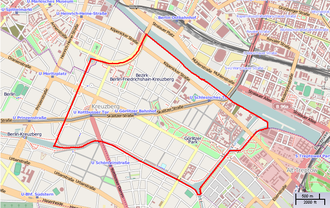Berlin SUN 36

Berlin SO 36 (short SO 36 or just 36 , also Kreuzberg 36 ) is the old name of the Berlin postal delivery district Südost 36 , which in addition to the Kreuzberg part also included part of Mitte and Alt-Treptow . After the introduction of the up to four-digit postcodes in the Federal Republic of Germany and West Berlin in 1962 and until the introduction of the five-digit postcodes in the reunified Germany in 1993, SO 36 had the address "1 Berlin 36" or from the 1970s "1000 Berlin 36" . The other part of Kreuzberg was numbered "1000 Berlin 61". The former Berlin 36 has had the postcodes 10997 and 10999 since 1993, while the former Kreuzberg 61 can be recognized by the numbers 10961 to 10969.
Background and history
SO 36 is still in the parlance these smaller part of Kreuzberg , the local situation than in the West by the now filled- Luisenstädtischer Channel and south of the Landwehr canal is limited.
Both parts of Kreuzberg are traditionally divided into several neighborhoods . SO 36 is considered poorer, and one can speak of a cultural difference to SW 61, which is generally more bourgeois (“36 burns, 61 sleeps”). Accordingly, since the late 1980s, the annual riots on May 1st have mainly been the scene of street battles on SO 36 .
From 1961 to 1990 SO 36 was separated from the former districts of Mitte , Friedrichshain and Treptow by the Berlin Wall . There was a border crossing point at the Oberbaum Bridge . The wall created a certain idyll here - the wall bounded SO 36 in the north, the Spree flowed in the east, and the Landwehr Canal in the south. From 1966 to 1977 it was official Berlin city planning to demolish large areas of SO 36 in order to make space for a new motorway route . As a result, many houses were unlet and left to decay; At the same time, it was often rented out to guest workers who were assumed to be in the country only temporarily, that is, they would have left it again by the time the motorway construction began.
The neighborhood's decline generally attracted low-income groups - the unemployed, students, and artists. This created a social mix that is still characteristic of the district today. After the student protests in 1968 , SO 36 increasingly became the center of the alternative scene and the scene of squatting , also due to its peripheral location near the border . On December 12, 1980 , the first serious street battles between squatters and the police took place here in the “ Battle of Fraenkelufer ”. The delivery district gave the club SO36 its name.
Immigration from home and abroad has changed the district significantly since the early 1960s. For people from the old federal states with non-bourgeois ideas about life and alternative political positions, Kreuzberg was a popular place of refuge during the time of division. The alternative scene shaped and continues to shape the culture of the quarter as well as the migrants , mostly of Turkish origin. Many long-established Kreuzbergers had to move away from Kreuzberg in the course of gentrification by foreign investors.
Today SO 36 is considered a social hotspot . Crime is increasing. Unemployment is high. A larger drug scene has been established at Kottbusser Tor for decades . The Görlitzer Park is also characterized by drug trafficking .
At the same time, the quarter is now one of Berlin's nightlife districts and is home to many students. The most important nightlife addresses in Kreuzberg 36 include Oranienstraße and Wiener Straße as well as the area around the Schlesisches Tor (the so-called “ Wrangelkiez ”). Long sections of Oranienstrasse are dominated by restaurants for young tourists.
The original post office for the then district was in 1907 at Görlitzer Bahnhof in Wiener Straße 33a. In 1927, the larger brick- built post office was built on the elevated railway on Skalitzer Strasse between the Görlitzer Bahnhof and Schlesisches Tor underground stations . Like all of the previous post offices that still existed, it operated for a long time as the “financial center” of Postbank , but is now closed.
See also
literature
- Martin Düspohl: Small Kreuzberg story . Kreuzberg Museum (Ed.) / Berlin Story Verlag , Berlin 2009, ISBN 978-3-86855-000-9 .
- Peter Frischmuth: Berlin Kreuzberg SO 36.Berlin Story Verlag, Berlin 2007, ISBN 978-3-929829-68-6 .
- Raimund Thörnig, Renate Freyer: ... unless you do it! Kreuzberg written off - got up. Association SO 36 e. V. (Ed.), Berlin 1989, ISBN 3-9800074-0-5 .
- Raimund Thörnig: ... unless you do it! Kreuzberg in transition. Volume 2. Association SO 36 e. V. (Ed.), Verlag Grenzenlos, Berlin 1992, ISBN 3-9800074-1-3 .
Web links
- Monument post office SO 36, 1925–1927
- Kreuzberg SO 36 on berlin.de
- Historical press release by BI SO 36 on the maintenance staff in Kreuzberg
- Kreuzberg's savior: renovation instead of total demolition - a Berlin district became a global model . In: Berliner Zeitung of October 27, 2007
- SOS for SO 36 . In: Der Spiegel . No. 13 , 1977 ( online ).
Individual evidence
- ↑ Boris Herrmann, Verena Mayer, Thorsten Schmitz, Jens Scheider: Notruf. In: Süddeutsche Zeitung , April 7, 2016, p. 3.
- ↑ Steffen Buhr: Berlin post offices.
Coordinates: 52 ° 30 ′ 0 ″ N , 13 ° 25 ′ 12 ″ E


